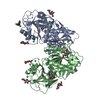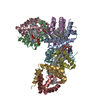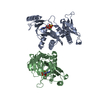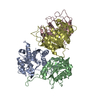登録情報 データベース : PDB / ID : 3q41タイトル Crystal structure of the GluN1 N-terminal domain (NTD) Glutamate [NMDA] receptor subunit zeta-1 キーワード / / / / / 機能・相同性 分子機能 ドメイン・相同性 構成要素
/ / / / / / / / / / / / / / / / / / / / / / / / / / / / / / / / / / / / / / / / / / / / / / / / / / / / / / / / / / / / / / / / / / / / / / / / / / / / / / / / / / / / / / / / / / / / / / / / / / / / / / / / / / / / / / / / / / / / / / / / / / / / / / / / / / / / / 生物種 Rattus norvegicus (ドブネズミ)手法 / / 解像度 : 3.4 Å データ登録者 Farina, A.N. / Blain, K.Y. / Maruo, T. / Kwiatkowski, W. / Choe, S. / Nakagawa, T. ジャーナル : J.Neurosci. / 年 : 2011タイトル : Separation of Domain Contacts Is Required for Heterotetrameric Assembly of Functional NMDA Receptors.著者 : Farina, A.N. / Blain, K.Y. / Maruo, T. / Kwiatkowski, W. / Choe, S. / Nakagawa, T. 履歴 登録 2010年12月22日 登録サイト / 処理サイト 改定 1.0 2011年3月23日 Provider / タイプ 改定 1.1 2011年7月13日 Group 改定 1.2 2020年7月29日 Group Data collection / Database references ... Data collection / Database references / Derived calculations / Structure summary カテゴリ chem_comp / entity ... chem_comp / entity / pdbx_chem_comp_identifier / pdbx_entity_nonpoly / struct_conn / struct_ref_seq_dif / struct_site / struct_site_gen Item _chem_comp.name / _chem_comp.type ... _chem_comp.name / _chem_comp.type / _entity.pdbx_description / _pdbx_entity_nonpoly.name / _struct_conn.pdbx_dist_value / _struct_conn.pdbx_leaving_atom_flag / _struct_conn.pdbx_role / _struct_conn.ptnr1_auth_asym_id / _struct_conn.ptnr1_auth_seq_id / _struct_conn.ptnr1_label_asym_id / _struct_conn.ptnr1_label_seq_id / _struct_conn.ptnr2_auth_asym_id / _struct_conn.ptnr2_auth_seq_id / _struct_conn.ptnr2_label_asym_id / _struct_ref_seq_dif.details 解説 / Provider / タイプ 改定 1.3 2024年11月27日 Group / Database references / Structure summaryカテゴリ chem_comp / chem_comp_atom ... chem_comp / chem_comp_atom / chem_comp_bond / database_2 / pdbx_entry_details / pdbx_modification_feature Item / _database_2.pdbx_DOI / _database_2.pdbx_database_accession
すべて表示 表示を減らす
 データを開く
データを開く 基本情報
基本情報 要素
要素 キーワード
キーワード 機能・相同性情報
機能・相同性情報
 X線回折 / SAD,SIRAS / 解像度: 3.4 Å
X線回折 / SAD,SIRAS / 解像度: 3.4 Å  データ登録者
データ登録者 引用
引用 ジャーナル: J.Neurosci. / 年: 2011
ジャーナル: J.Neurosci. / 年: 2011 構造の表示
構造の表示 Molmil
Molmil Jmol/JSmol
Jmol/JSmol ダウンロードとリンク
ダウンロードとリンク ダウンロード
ダウンロード 3q41.cif.gz
3q41.cif.gz PDBx/mmCIF形式
PDBx/mmCIF形式 pdb3q41.ent.gz
pdb3q41.ent.gz PDB形式
PDB形式 3q41.json.gz
3q41.json.gz PDBx/mmJSON形式
PDBx/mmJSON形式 その他のダウンロード
その他のダウンロード 3q41_validation.pdf.gz
3q41_validation.pdf.gz wwPDB検証レポート
wwPDB検証レポート 3q41_full_validation.pdf.gz
3q41_full_validation.pdf.gz 3q41_validation.xml.gz
3q41_validation.xml.gz 3q41_validation.cif.gz
3q41_validation.cif.gz https://data.pdbj.org/pub/pdb/validation_reports/q4/3q41
https://data.pdbj.org/pub/pdb/validation_reports/q4/3q41 ftp://data.pdbj.org/pub/pdb/validation_reports/q4/3q41
ftp://data.pdbj.org/pub/pdb/validation_reports/q4/3q41 リンク
リンク 集合体
集合体


 要素
要素
 Homo sapiens (ヒト) / 参照: UniProt: P35439
Homo sapiens (ヒト) / 参照: UniProt: P35439 X線回折 / 使用した結晶の数: 1
X線回折 / 使用した結晶の数: 1  試料調製
試料調製 回転陽極 / タイプ: RIGAKU MICROMAX-007 / 波長: 1.5418 Å
回転陽極 / タイプ: RIGAKU MICROMAX-007 / 波長: 1.5418 Å 解析
解析 ムービー
ムービー コントローラー
コントローラー











 PDBj
PDBj








